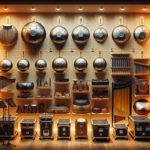In a world teeming with noise and fast-moving interactions, finding solace in the tranquility of music has become a cherished means of unwinding. Among the myriad of musical instruments vying for our attention, the handpan stands out due to its ethereal and captivating sound. As an instrument reminiscent of the steelpan but enhanced with a deeper, mellow tone, the handpan has garnered a following among those seeking both musical and therapeutic experiences.
Originating in the early 2000s, the handpan is a relatively recent addition to the family of percussion instruments. It is crafted from two half-shells of steel, bonded together to form a resonant chamber. The top shell, featuring a central note called the Ding and a series of tone fields arranged in a circle, is where the magic happens. This minimalist yet elegant design allows for an array of harmonious and soothing sounds that can evoke a sense of calmness and introspection.
The Therapeutic Potential of Music
The notion of music as a therapeutic tool is far from new. For centuries, various cultures have used music to heal the mind, body, and soul. From ancient Greek physicians who used musical rhythms to treat patients to modern-day music therapists who employ carefully selected sounds to alleviate mental and physical ailments, the transformative power of music is undeniable.
Music therapy, recognized as a clinical intervention, utilizes the emotional and psychological impacts of music to support individuals in achieving specific health goals. It can address a wide range of needs, from reducing anxiety and improving mood to aiding in physical rehabilitation and pain management. The unique soundscapes of the handpan make it a particularly effective instrument for these purposes.
Handpan Music: A Gateway to Relaxation and Healing
The enchanting tones of the handpan have a natural ability to induce relaxation and facilitate a meditative state. The reasons for this are multifaceted. Firstly, the instrument’s inherently harmonious sounds resonate with the body’s own frequencies, helping to align and balance one’s internal energies. Listening to or playing the handpan can slow down the listener’s heart rate and encourage deep, rhythmic breathing—both foundational elements in achieving relaxation.
Furthermore, the repetitive yet varied patterns of handpan music can help to occupy the mind and detract from stressful thoughts. This auditory focus can serve as a form of sound-based mindfulness, where the listener remains present in the moment, fully immersed in the rich tapestry of sounds produced by the instrument.
Vibrational Healing and the Handpan
Beyond its auditory appeal, the handpan can also be understood through the lens of vibrational healing. Everything in the universe, including the human body, is composed of vibrations, and each part of the body has its own unique frequency. When these frequencies are out of sync, it can result in physical or emotional dis-ease.
The handpan’s vibrations can help to recalibrate these frequencies. As the instrument is played, the vibrations it emits can permeate the body and stimulate a process known as entrainment. This process allows the body’s natural rhythms to align with the handpan’s harmonious vibrations, promoting a sense of equilibrium and well-being. Many individuals who engage with handpan music report a tangible sense of release and an uplifted mood, as if the instrument’s vibrations have washed away their stresses and worries.
Handpan Music in Therapeutic Settings
Given its profound impact, it’s no surprise that handpan music has found its way into therapeutic settings. Music therapists and holistic practitioners are increasingly incorporating the instrument into their sessions. In environments such as hospitals, rehabilitation centers, and wellness retreats, handpan music is used to create a calming atmosphere and support the therapeutic process.
Specific applications can range from aiding in stress reduction for patients undergoing medical treatments to facilitating deep relaxation during massage therapy sessions. The versatility of the handpan means it can complement a wide array of therapeutic practices. For example, in group therapy sessions, the handpan can help to build a sense of connection and shared experience among participants, enhancing the overall therapeutic outcome.
The Role of the Handpan Player
While the instrument itself plays a significant role, the skill and intention of the handpan player are equally crucial. Each player brings their own energy and interpretation to the music, which can influence the listener’s experience. A skilled handpan player can intuitively navigate the instrument’s tone fields to create a melodic journey that resonates deeply with the audience.
Moreover, the player’s own emotional and mental state can affect the music produced. When the player is fully present and engaged, the resulting music is imbued with a healing quality that listeners can instinctively feel. This dynamic interplay between the instrument and the player highlights the handpan’s potential as a tool for both personal expression and communal healing.
Conclusion
In the quest for wellness and inner peace, the handpan emerges as a remarkable instrument, capable of bridging the gap between sound and healing. Its unique, resonant tones provide a sanctuary from the hustle and bustle of everyday life, inviting us to slow down, breathe deeply, and reconnect with our inner selves. Whether used in professional therapeutic settings or personal meditation practices, the handpan offers a profound auditory experience that can lead to transformative healing and relaxation.
As we continue to explore the intersections of music and wellness, the handpan stands out as a beacon of tranquility and restoration. Its healing vibes remind us of the profound impact that sound can have on our overall health, mesmerizing us with its simplicity and depth. In a world that often demands constant action and thought, the handpan gently encourages us to pause, listen, and find harmony within ourselves.
Frequently Asked Questions
1. What is a handpan?
A handpan is a percussion instrument crafted from two half-shells of steel, bonded together to form a resonant chamber. It features a central note called the Ding and several tone fields arranged in a circle, which produce harmonious and soothing sounds when struck.
2. How does handpan music aid in relaxation?
Handpan music induces relaxation by producing harmonious sounds that resonate with the body’s own frequencies, helping to align and balance internal energies. Its repetitive yet varied patterns can occupy the mind and reduce stressful thoughts, promoting deep, rhythmic breathing and a meditative state.
3. Can handpan music help with physical ailments?
Yes, handpan music can assist with physical ailments by promoting relaxation and reducing stress, which are key factors in the body’s healing process. The instrument’s vibrations can help recalibrate bodily frequencies and encourage a sense of equilibrium, aiding in overall well-being.
4. Where is handpan music commonly used in therapy?
Handpan music is used in various therapeutic settings such as hospitals, rehabilitation centers, wellness retreats, and during massage therapy sessions. It helps create a calming atmosphere and supports the therapeutic process, enhancing outcomes in stress reduction, pain management, and emotional healing.
5. Do I need to be a trained musician to play the handpan?
No, you don’t need to be a trained musician to play the handpan. Its design and layout are intuitive, allowing anyone to produce pleasant sounds with minimal practice. However, refining your skills and understanding the nuances of the instrument can enhance your ability to create more therapeutic and immersive musical experiences.





